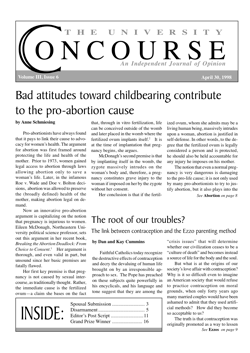Winner of the third annual Concourse Grand Prize
by the editors
Announcing:
The third annual Concourse Grand Prize:
Dinner for two at the
Grand Concourse Restaurant in Pittsburgh
to be awarded to the author of the article (excluding those by staff and board members), which, in the judgment of the editors, best reflects the Concourse ideal of fruitful Christian discourse.
This year’s winner is junior philosophy major
MICHAEL HEALY
for his issue 5 article:
How hobbits and company might really exist
Such flabbergasting Tolkien-knowledge as this piece displayed is prize-worthy in itself, but the editors were still more impressed by the article’s unique mix of fantasy and philosophy, and the light-hearted thoughtfulness with which the author treated his subject matter. The following excepts from the end of his article, will serve to show how deserving it is of this year’s prize.
I think that these arguments demonstrate that according to Tolkien’s conception of the Elves they could indeed exist. Proving the possibility of the existence of the Dwarves would in general follow along the same lines, though the strange story of their creation complicates things. Tolkien states in the second chapter of the “Quenta Silmarrilion” that the Dwarves believe that they have immortal souls, but that the Elves disagreed. However, since Dwarves can speak and learn and remember and love, I think Tolkien conceived of the Dwarves too as having immortal souls. If he did, it is possible, by these arguments, that they too could exist.
What of the other races of Middle-Earth? To the best of my knowledge, too little is said about the nature of the giants, the monster in the mere outside Moria, the trolls, the Mewlips, or the giant turtles to determine whether they could exist. “Eru, the One, who in Arda is called Iluvatar” is the One True God. The Ainur, the Valar, and the Maiar are the Angels. Melian, Gandalf, Saruman, Radagast, Tom Bombadil, Goldberry, the Ents, and the two “Blue Wizards” are Maiar who have taken bodily form—that is, they are “angels incarnate.” Morgoth, or Melkor, is Satan. Sauron is whatever demon is second to Satan. Balrogs, Dragons, werewolves, vampires, and giant spiders are other demons. Therefore, it is unquestionable that they all exist on the spiritual plane. Whether they could exist as Tolkien depicts them depends on whether angels and demons could adopt physical forms and dwell among us.Barrow-wights are demonically possessed corpses. The Nazgul are humans who live continuously on earth through demonic magic and whose bodies do not decay. Instead they gradually become more and more insubstantial until, despite the fact that they still have bodies and may yet be slain, they literally look like ghosts. Gollum, of course, is a hobbit who started down their path but never completed it…
I must admit, though, that I personally do not believe that Elves, Dwarves, or Orcs exist. Nor do I believe that there is intelligent life on other planets. Yet this is only because I do not yet see any convincing proof that non-human sentient physical beings exist. I do not think that Catholic doctrine makes the existence of other intelligent life forms impossible. For we cannot fathom the mind of God, and if it has pleased Him to create other intelligent races for us to share this universe, or even this planet, with, we must admit that it is within His power to create them. If He has done so we may never know His reasons for creating them. But we do know that if we meet any non-human sentient life forms we must accept their existence as His will—and we must evangelize them.
Honorable mention also goes to Mary Healy (MA class of ‘88; no known relation to Michael) for her exceptionally thoughtful, and informative Issue 3 reply to a reader inquiry concerning the absence of the Real Presence in the creeds.
Though very different in style and subject matter, each of these articles is an outstanding example of the sort of cultivated Christian conversation the Concourse was designed to foster. Our thanks and congratulations to both writers.


